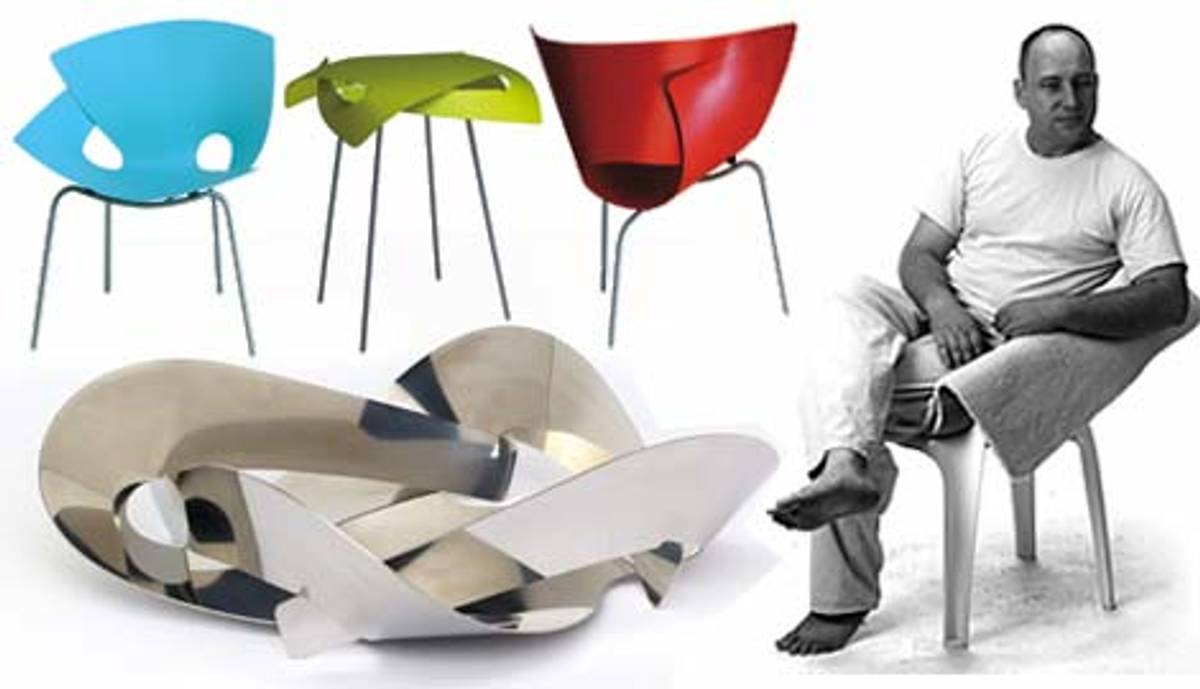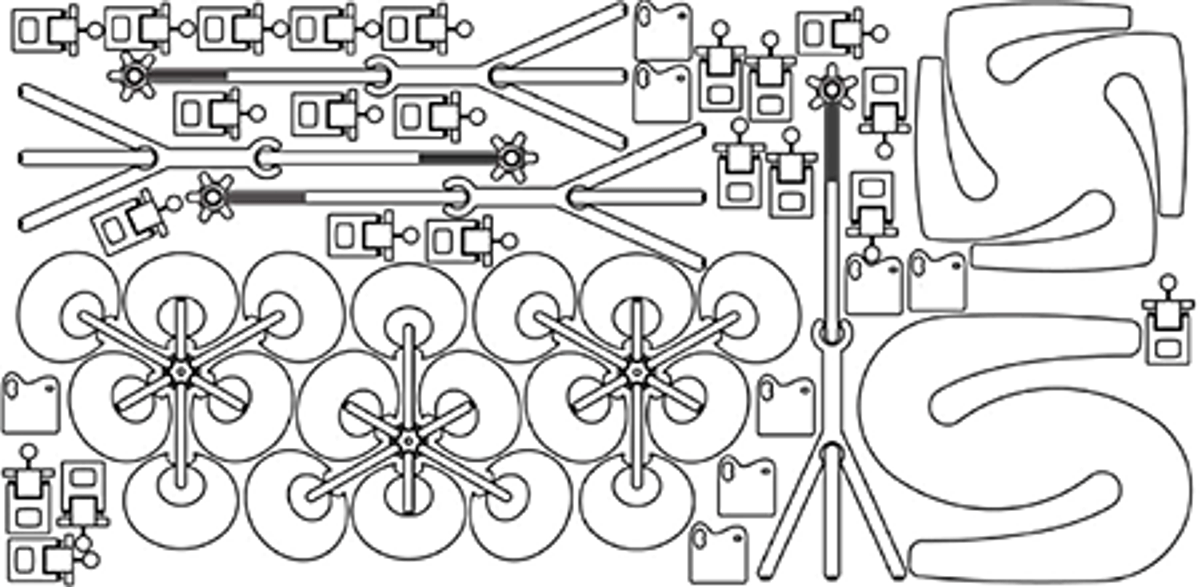Ronen Kadushin’s elegant, ultra-simple furniture—much of it laser-cut from single sheets of painted steel and manipulated into odd, organic shapes—has earned him international praise, endless awards, and, of course, a fair amount of good, old-fashioned cash. So his fellow designers were shocked when, last year, he started offering the blueprints for his designs as free downloads on his website. Kadushin trusts that manufacturers who sell his works commercially will voluntarily pay him royalties for the privilege, and so far, his faith hasn’t been misplaced. His is the first such open-source model for industrial design and has the potential to revolutionize the design field, much as Linux did the software industry.

Sixty years ago, your parents fled the Nazis and settled in Israel. Last year, you moved from Israel to Berlin, just as you were launching Open Design. Why?
We wanted an adventure, my wife and I. It was between Barcelona, Amsterdam, Berlin, London. Berlin came out as the winning city—it’s cool and easygoing. Also Germany is the last country in Europe where it’s still relatively easy to get a working visa.
Did you get any flak back home about the move?
Of course. There’s a generational gap, though. To my former students [at Hadassah Academic College and Shenkar College of Engineering and Design], Berlin is a cool city: lots of art and music; interesting, big and cheap. They know about the Holocaust, but they figure: “Well, that’s part of the deal. We’ll get to that later.”
The older generation is more suspicious. Germany is still a frightening word in Israel. It brings about a lot of memories—even if they aren’t your own. It’s communal memory.
I’m between the young and old generations. I’m as indoctrinated in the history as any, and moreover I’m very interested. The first months were an adjustment period. My reflexes were always on. If somebody’s yelling in German, you get associations in your mind. Boom.
When my husband and I moved here from New York, we were fascinated by how curious Berliners seemed about Judaism. But, at least with us, they’re hesitant to ask.
If I meet a German, let’s say the second or third time, the subject comes up. They consider themselves the other side of the same [historical] coin, and they’re extremely educated about this.
Germany is doing a lot more than other countries [to acknowledge the Holocaust]. They took responsibility. And for this, I have a lot of appreciation. You don’t see this in other countries, like France or Holland.
They always say: “Oh, they made us do it. Oh, we had a Resistance.” All these bullshit stories to make themselves feel better. Except Germany, who openly accepts the responsibility, the historic facts, and works to integrate them into all levels of national awareness. I admire this. You can see 60 years of liberal, historically aware education in the people I meet. They know a lot about this, from their side at least. And they want to know from the other side, too. It’s about releasing tensions.
What do they usually ask you?
We slip into it, talking about politics, or my observations about Germany. They want to know about my parents’ war experiences, about my feelings towards Germany, the language, the history. They’re curious. It’s a dialogue, not an interview.
What did happen with your parents during the war?
They were chased by the Nazis but survived. My father’s family ran from Vilnius to Tajikistan, Asian Russia, then to Israel in 1948. My mother fled as a child from Poland to Tajikistan, then back to Poland. She went to Israel in 1957 after [Władysław] Gomułka planned his pogroms. Other parts of the family were murdered.
Now my father is an aeronautical engineer. A rocket scientist, in fact. My mom was a bookkeeper, but she paints, too. So we’d go to museums together when I was little.
How did they react when you moved to Berlin?
Not good! Not good! [Laughs.] I was leaving my nice teaching post and security and pension plans, everything I’d built in Israel, and I was going to Germany. They didn’t like the idea, but really they didn’t say too much. They know there’s a different Germany now.
Of course, my friends were laughing: “What will happen if suddenly the political climate changes and the Nazis come?” And I say: “Well, I’ll run away in time, okay? I know this experience from 60 years ago. I will know when to run.” This kind of joking. You can joke a lot about it, because really it’s a strange situation. Humor is one way to deal with it.
Do you miss Israel?
I miss friends, I miss family, I miss some places. But I don’t miss Israel as an everyday existence. I’m totally connected: I check the news six times a day because everything changes so fast. But here I just feel better, more secure. The earth is not moving under my feet all the time.
How did you conceive of Open Design?
In 2000 I did an exhibition of a series called Thinology. I take a flat piece of material and force it to become the shape I want without breaking. The material has to say something, it has opinions and characteristics. So when you bend it, you meet in the middle. You work out an agreement.
My friend, Kenny Segel, wrote in a text for this exhibition that my designs are so ephemeral, so

bordering on the non-existent, the next stage will be that you download them from the Internet. He was the first to say this. At that time, my work was becoming more just lines, flat, just information, but I was still focused on material. He saw the big picture.
When did you make the leap to what is, essentially, open-source design?
I was struggling for an idea for my master’s thesis, at Middlesex University. Simplicity? Simple furniture? Then it hit me: it’s not about simplifying the product, it’s about the production method. The object is not just the object.
I start researching open-source, file-sharing—all these democratic and unbiased ideas that are changing creativity. It’s a real issue. Companies are pushing to control their intellectual property – music, games, whatever—and the other side is pushing to be free. The consumer is in the middle.
How big of a departure is Open Design from the conventional industrial design process?
Industrial design is not about sharing; it’s like this. [Raises a clenched fist.] It’s completely copyrighted, to protect investments in things like tooling and marketing. After that, a product’s average lifespan is only 18 months. To reissue something, the producer has to invest more money, re-assemble the tooling, redo all the production procedurals. It creates a very distorted situation. Creativity is not flowing.
So with Open Design I reduced my design, the method, to where there’s no tooling investment required; it’s for no specific producer. Instead of being like this [clenches a fist], I’m like this [opens his palm flat]. I have a Creative Commons license, but you can download the design, copy it, or modify it. It’s ready for production, no secrets, no patents. If you want to produce my designs commercially, let’s share the profits.
What’s the incentive for not just stealing your work?
The producer realizes: if he pays me, I’ll keep doing this, and he’ll have more designs to choose from. His payment ensures the method will continue.
But once you realize you can do this, you feel free. If you’re open-handed, people are open-handed to you. They won’t even think about closing off. I find the good side of people, all the time. [Laughs.] It’s a world without lawyers.
How do you imagine Open Design’s future?
If this catches on, manufacturers could take from an open pool of ideas where many designers contribute. The designer doesn’t marry the company.
It also means my designs are future-proof. They’re never fully out of production. Remember a song you liked when you were 12? Now that music is digital, it has a life that never ends. I want the same to happen to design. A hundred years from now, I won’t be here, but my designs can be.
How has being in Berlin influenced your designs?
Living in Berlin makes me more easy in my work. I can be cool about experimenting and not be so concerned with consequences. Because Berlin has this relaxed atmosphere, this variety, this size and space, you can breathe more easily here. It makes you design in a different way.
Of all the conversations you’ve had with Germans—on Judaism and Germany’s thorny history—do any really stand out?
I have a dog-friend—you know, somebody you meet walking the dog. He’s from Graz in Austria, but he lives in Berlin. His grandfather was a personal friend of Hitler, a doctor and later an SS official. His family never left Nazism, so he ran away from them, but he’s completely fucked up. I was fascinated, because he knew a lot of facts I’d never heard. Who Hitler’s friends were; how he rose from nothing. He was filling up my gaps.
[This friend’s] father died of a genetic disease. In the hospital bed, the grandfather came and told the father, his own son: “I think it’s good you’re dying. Your genes aren’t good enough to reproduce.”
Meanwhile, the father came from the grandfather’s genes. It’s so self-hating.
Well, the grandfather didn’t have these diseased genes; that’s what he meant. Suddenly you realize: Nazism isn’t just about hating Jews. It’s a larger belief about supremacy of race, starting with genes. It’s not just politics, it’s belief, it’s religion. So I learn new things, from the guy from Graz.
You know, I have a hobby here of identifying Nazi buildings.
Have you seen the World Cup stadium?
Just from afar. But have you seen Tempelhof, the airport? DA DA DA, DA DUH DA—It’s Star Wars, the Evil Empire. A lot of buildings here are converted, but you can still tell. I suspect the building of being Nazi, I ask friends, then I check the web. I’m the Simon Wiesenthal of architecture.
I have this image of you and the dog-friend, apparently relaxing, while he tells this deathbed story. It’s pretty heavy for the park.
When his mom died, he had to come back to Graz. He was not sleeping nights. He brought me photographs of Hitler. Personal photos!
This reminds me of your open-hand idea. It’s surprising how often people meet your openness with their own.
I tell him: “Tell me! Tell me about it.” I want to know. I’ve read many books, but when somebody tells you a story at the park about his grandfather—now I understand more.